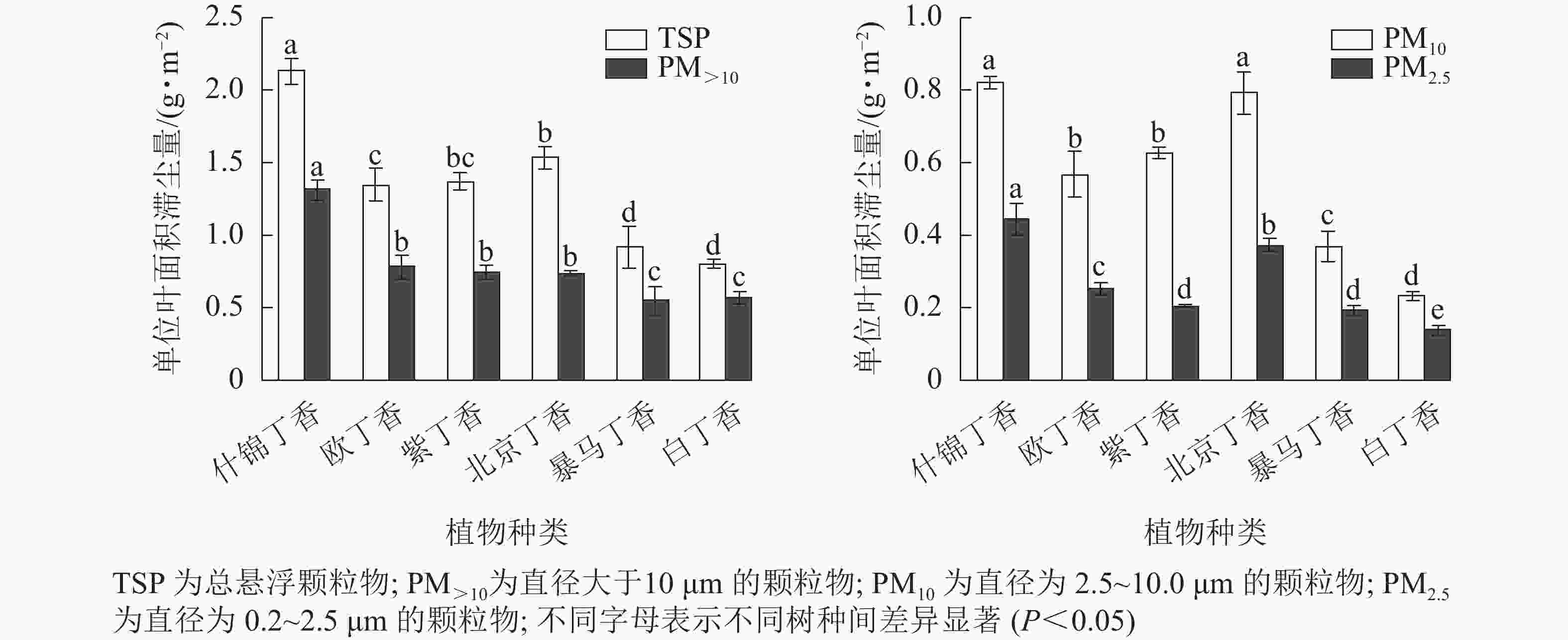-
近年来,随着城市化和工业化进程的加快,环境污染问题愈发严重,其中秋冬季节多地频发的雾霾天气使空气污染成为人们高度关注的重大问题[1]。目前,空气中悬浮的颗粒物不仅加剧城市“热岛效应”,影响气候变化,恶化人们生活环境,甚至还影响人类身体健康,引起呼吸系统和心脑血管系统疾病[2-3]。研究表明:园林植物能够有效吸滞空气中的微小颗粒,从而改善空气环境质量[4-6]。丁香是木犀科Oleaceae丁香属Syringa的落叶灌木或小乔木,其植株秀丽多姿,花色淡雅,花香怡人,抗逆性极强[7],作为独特的观赏树种在西北园林中扮演着重要的角色。但是不同的树种综合滞尘能力均有差异,且关于园林植物的滞尘能力与调控机制的研究大多集中在不同城市常见园林植物[8-13]。XU等[14]研究表明紫丁香S. oblata对不同粒径颗粒物都表现出较强的吸滞能力,黄靖懿[15]对哈尔滨市12种常见树木滞尘能力进行研究发现丁香的滞尘能力可以排在第2位,于宁[16]对青岛市居住区19种主要灌木树种的滞尘能力等生态作用进行测定,发现丁香属植物具有较高的生态价值,可以较好地吸滞细颗粒物。丁香属很多分类群的性状变异非常复杂[17],其单位叶面积和微形态结构都具有很大差异[18],但是目前缺少对不同种丁香间的滞尘效应差异研究,因此,本研究测定6种丁香属植物在满叶期对不同粒径颗粒物的滞留量,分析评价丁香属植物对不同粒径颗粒物的滞留能力,同时通过扫描电镜对植物叶表面微观结构进行观察,探究微观结构对植物滞尘能力的影响,以期筛选出滞尘能力较强的丁香属植物,为丁香在城市绿化中的合理利用提供科学依据。
-
供试材料为6种丁香属植物(表1)叶片采自西北农林科技大学南校区,该地区属于暖温带半湿润气候区,年均降水量为637.6 mm,7—10月为多雨季节[19],试验于2020年10月24日至11月2日进行。
表 1 6种丁香的基本情况
Table 1. Basic information of six species of Syringa
树种 株高/m 冠幅/m 周边环境 什锦丁香Syringa chinensis 2.75~3.45 2.40~3.35 道路(南)、道路(西) 欧丁香S. vulgaris 3.55~4.85 3.20~3.95 道路(东)、群植玉兰(南) 紫丁香S. oblata 3.70~4.65 3.05~4.02 道路和建筑(南)、雪松(西) 北京丁香S. pekinensis 4.50~5.50 3.97~5.03 道路(南)、群植金银木(北) 暴马丁香S. reticulata var. amurensis 4.75~5.78 4.04~5.15 道路(南)、群植金银木(北) 白丁香S. oblata var. alta 3.50~3.97 3.40~4.11 道路(东)、群植玉兰(南) 说明:玉兰Magnolia denudata,雪松Cedrus deodara,金银木Lonicera maackii 通过3级滤膜过滤法[20]进行6种丁香属植物叶面滞尘量的测定,并且使用扫描电镜[21]对丁香属植物叶片微观结构进一步观察。滤膜由北京海成世洁过滤器材有限公司提供。
-
采样日期选择在降雨后第7天(累积降雨量达27 mm以上),采样时间段为9:00—11:00,采样高度离地面约2 m,选择3株生长状况一致的树种,在树冠外围东南西北共4个方位,上中下取健康完整叶片,每包叶片的采集面积控制在约200 cm2,重复3次,小心封样后立即带回实验室进行处理。
-
预处理微孔滤膜,即微孔滤膜材料均用蒸馏水充分浸泡24 h,于105 ℃下烘干至恒量,用万分之一天平称量待用。将采集的叶片材料浸泡2 h后,软毛刷清洗叶片正反面粉尘,洗涤3次,洗涤工具同样再冲洗3次,收集全部洗液待用,然后使用10.0、2.5、0.2 μm孔径的聚脂膜过滤,在恒温干燥箱干燥(60 ℃)后,用万分之一天平称量直至质量无变化。材料所吸附的各粒径颗粒物的质量为微孔滤膜过滤前后差值,将洗净的全部样品叶片贴于塑料板上,使用活体叶面积仪(LI-3000C)测单叶面积,样品总面积为植物单叶面积之和。计算各植物总悬浮颗粒物(TSP)、直径大于10.0 μm的颗粒物(PM>10)、直径为2.5~10.0 μm的颗粒物(PM10)、直径为0.2~2.5 μm的颗粒物(PM2.5) 滞留量与叶片总面积的比例,得到单位叶面积上各粒径颗粒物的滞留量。
-
每种植物采集3片健康完整叶片,避开主叶脉随机切取5 mm×5 mm正方形,使用TM 3000台式扫描电镜观察叶表面微观结构并拍照,统计叶表皮气孔密度、气孔长度、宽度和沟槽宽度等数据。
-
采用Excel和SPSS 26.0对数据统计分析,使用Origin 2018作图。
-
由图1可知:不同种丁香对不同粒径颗粒物的滞尘能力存在显著差异(P<0.05),6种丁香单位叶面积滞尘能力从大到小依次为什锦丁香、北京丁香、欧丁香、华北紫丁香、暴马丁香、白丁香。什锦丁香的单位叶面积滞尘能力最强,单位叶面积TSP、PM>10、PM10和PM2.5滞尘量均显著高于其他丁香(P<0.05),分别为2.13、1.31、0.82和0.44 g·m−2;北京丁香次之,单位叶面积TSP、PM10和PM2.5滞尘量除什锦丁香外均显著高于其他4种丁香(P<0.05),分别为1.53、0.79和0.37 g·m−2;欧丁香和紫丁香单位叶面积TSP、PM>10、PM10之间无显著差异(P>0.05),欧丁香单位叶面积PM2.5滞尘量显著高于紫丁香(P<0.05);暴马丁香和白丁香最差,白丁香单位叶面积PM10和PM2.5滞尘量均最低,显著低于其他5种丁香(P<0.05),分别为0.23和0.14 g·m−2。
-
从图2可以看出:各丁香属植物叶片上表面滞留大粒径颗粒物较多,褶皱处密布粉尘颗粒物,说明叶片上表面是吸附颗粒物的主要部位。什锦丁香的滞尘能力最强,其叶片上表面沟槽明显,起伏程度较大,叶片下表面气孔周围褶皱密集,有助于滞留颗粒物;欧丁香上下表面都较粗糙,尤其是叶片上表面褶皱数量多且密,微小颗粒物被拦截在褶皱凹陷区域;紫丁香上表面沟槽较浅,下表面气孔突出,下表面颗粒物较少;北京丁香叶片上表面具有不规则的凸起,下表面粗糙,有利于滞留粉尘颗粒物;暴马丁香上表面较光滑平整,分布粉尘颗粒物较少,下表面气孔内陷;白丁香沟槽较浅,粉尘颗粒物附着能力较弱。综合来看,主要是叶片上表面承担滞留粉尘颗粒物的作用,什锦丁香叶片上表面的深沟壑有利于粉尘颗粒物的滞留,白丁香和暴马丁香的滞尘能力较差,因为其上表面结构较光滑平整,不易于滞留粉尘颗粒物。
-
从表2可以看出:不同植物的叶表微观结构具有显著差异(P<0.05),北京丁香叶片下表皮气孔密度均显著高于其他5种丁香(P<0.05);欧丁香和白丁香的气孔长度显著高于什锦丁香、北京丁香、暴马丁香和紫丁香(P<0.05);紫丁香的气孔宽度均最低;什锦丁香和紫丁香的上表皮沟壑宽度最宽,什锦丁香下表皮沟壑宽度最宽。
表 2 6种丁香属植物叶片表面微结构参数
Table 2. Leaf surface structure parameters of 6 species of Syringa
树种 SD/(个·视野−1) SL/μm SW/μm GWU/μm GWL/μm UTSP/(g·m−2) UPM2.5/(g·m−2) 什锦丁香 20.00±2.00 cd 23.47±1.84 b 7.82±0.81 ab 7.79±0.72 a 3.43±1.31 b 2.13±0.09 a 0.44±0.04 a 欧丁香 21.30±0.58 cd 25.80±1.46 a 9.00±0.73 a 3.69±0.24 b 2.16±0.15 c 1.35±0.11 c 0.25±0.02 c 紫丁香 22.70±1.53 c 18.73±0.62 c 6.07±0.88 c 7.20±1.93 a 2.78±0.38 bc 1.37±0.06 bc 0.21±0.00 d 北京丁香 55.30±1.15 a 12.15±1.06 d 7.19±0.66 bc 3.05±0.46 b 3.82±0.35 ab 1.53±0.07 b 0.37±0.02 b 暴马丁香 31.30±2.08 b 16.70±1.56 c 7.50±0.50 b 0.00±0.00 c 2.35±0.26 c 0.91±0.15 d 0.19±0.01 d 白丁香 18.70±2.31 d 26.28±0.44 a 6.72±0.39 bc 3.01±0.52 b 4.88±0.41 a 0.80±0.03 d 0.14±0.01 e 说明:SD为下表皮气孔密度,在500倍视野下测量,SL为气孔长度,SW为气孔宽度,GWU为上表皮沟壑宽度,GWL为下表皮沟壑宽度,UTSP为单位叶面积总悬浮颗粒物滞留量,UPM2.5为单位叶面积PM2.5直径为0.2~2.5 μm的颗粒物滞留量。同列不同字母表示不同树种间差异显著(P<0.05) 由表3可知:从相关系数来看,气孔宽度与UTSP和UPM2.5滞留量可达显著负相关,相关系数和显著性分别为R2=−0.676,P=0.016;R2=−0.679,P=0.015。但是Pearson法对两者进行相关性分析时,偏相关分析法可以有效控制其他相关量,从而排除其他因素的影响,从偏相关系数来看,叶表微结构(气孔密度、气孔长度、气孔宽度、上表皮沟壑宽度和下表皮沟壑宽度)与滞尘量(UTSP和UPM2.5)均未达显著相关(P>0.05)。
表 3 6种丁香属植物叶表显微结构参数与滞尘能力之间的相关性
Table 3. Correlation between microstructure characteristics of leave surface and the dust detention ability of 6 species of Syringa
影响因素 UTSP UPM2.5 控制变量 相关系数 偏相关系数 相关系数 偏相关系数 SD −0.026 0.098 0.033 0.096 SL、SW、GWU、GWL SL 0.058 0.099 0.009 0.080 SD、SW、GWU、GWL SW −0.676* −0.676 −0.679* −0.657 SD、SL、GWU、GWL GWU 0.312 0.348 0.210 0.213 SD、SL、SW、GWL GWL 0.182 −0.089 0.212 0.005 SD、SL、SW、GWU 说明:SD为下表皮气孔密度,SL为气孔长度,SW为气孔宽度,GWU为上表皮沟壑宽度,GWL为下表皮沟壑宽度,UTSP为单位叶 面积总悬浮颗粒物滞留量,UPM2.5为单位叶面积PM2.5直径为0.2~2.5 μm的颗粒物滞留量。*P<0.05 -
叶片表面粗糙程度、上下表面沟壑宽度、表皮毛数量、分泌物等因素都可以影响植物叶片吸滞粉尘颗粒物能力[6, 21-24]。本研究通过微观结构观察发现植物叶片主要是上表面承担滞留粉尘颗粒物的作用,这一结果与王蕾等[25]和石婕等[9]的研究结果相同。雨水冲刷、风等外力条件可以使植物滞留的粉尘颗粒被冲刷,起伏较深的沟壑可以有效吸附粉尘颗粒物[23],因此什锦丁香叶片上表面的深沟壑有利于粉尘颗粒物的滞留,白丁香和暴马丁香的滞尘能力较差是因为其上表面结构较光滑平整,不易于滞留粉尘颗粒物。
目前,大多数滞尘微形态结构研究结果不尽相同,王蕾等[25]和刘璐等[26]研究发现:植物叶片气孔越大,滞尘能力越强。李艳梅等[21]研究表明气孔孔径与植物滞尘能力无显著关系。本研究分析丁香植物叶片微结构参数与滞尘相关性,发现气孔宽度与UTSP和UPM2.5达显著负相关,说明植物叶片气孔宽度越窄,植物滞尘能力越强,气孔宽度对植物滞尘具有重要作用,但是植物滞尘效应研究影响因素复杂,需要排除其他因素的影响。从偏相关系数来看,叶表微结构(气孔密度、气孔长度、气孔宽度、上表皮沟壑宽度和下表皮沟壑宽度)与滞尘量(UTSP和UPM2.5)均未达显著相关(P>0.05),该结果与王琴等[8]和李艳梅等[21]的研究结果不一致,说明叶片上下表皮沟壑宽度还未能显著影响丁香属植物滞尘效果,因此本研究所选定量指标并不是丁香属植物叶滞纳大气颗粒物的功能指标,沟壑深度可能是影响丁香属植物滞尘的因素之一,植物滞尘机制还需进一步研究,以探究出影响植株滞尘效应的调控机制[6]。
综上所述,什锦丁香在6种丁香属植物中单位叶面积滞尘能力最强,宜作为优良的园林滞尘灌木树种,在工业聚集区、校园、道路等地方广泛应用,具备观赏价值的同时,能有效减轻城市粉尘颗粒物污染,对增强环境效益和观赏性发挥积极作用;紫丁香、欧丁香适合种植在校园、居民居住区、商业街道等污染较轻的区域,在应对雾霾等严重的空气污染,滞留粉尘颗粒物能力表现比较优良;暴马丁香和白丁香的单位叶面积滞尘能力各方面都较弱,可以作为生态旅游区绿化树种。因此,在丁香配置种植时,需要因地制宜,实现园林植物调控空气污染颗粒物效益的最大化、最优化。
Dust-retention capability evaluation of six species of Syringa and their leaf surface micromorphology
-
摘要:
目的 筛选滞尘能力较强的丁香属Syringa植物,促进丁香在城市绿化中生态功能的发挥。 方法 以6种丁香属植物为研究材料,在满叶期通过3级滤膜过滤法测定植物经过不同孔径的滤膜后滞留的各直径颗粒物,并对丁香属植物叶表面微观结构进行观察,探究叶片微观结构对植物滞尘效应的影响。 结果 ①丁香属植物对不同粒径颗粒物的滞尘能力存在显著差异(P<0.05),对于满叶期,6种丁香单位叶面积滞尘能力从大到小排序为什锦丁香S. chinensis、北京丁香S. pekinensis、欧丁香S. vulgaris、紫丁香S. oblata、暴马丁香S. reticulata var. amurensis、白丁香S. oblata var. alta。②什锦丁香单位叶面积滞尘能力最强,通过微观结构观察发现什锦丁香叶片上表面沟槽纵深,下表面气孔周围褶皱密集,有助于滞留颗粒物。③从偏相关系数来看,叶表微结构各参数与单位叶面积总颗粒滞留量(UTSP)和直径为0.2~2.5 μm颗粒物滞留量(UPM2.5)均未达显著相关(P>0.05)。 结论 沟槽的深度可能是影响植物滞尘的原因之一,在治理城市空气污染时,什锦丁香可作为优良的园林滞尘灌木树种。图2表3参26 Abstract:Objective This study is aimed to screen out Syringa plants with strong dust-retention capability so as to promote the ecological function of Syringa in urban greening. Method With six species of Syringa selected as the research materials, the three-layer filter method was first used to determine the particles of plants passing through filters with different pore sizes during the full-leaf period. Then the micromorphology of the leaf surface of the Syringa was observed before an investigation was conducted of the influence of the leaf micromorphology and the dust retention effect of the plant. Result (1) there were significant differences in the dust retention capabilities of Syringa plants(P<0.05) with the order of the comprehensive dust-retention capability per unit leaf area of the 6 Syringa species for the full-leaf stage being S. chinensis>S. pekinensis>S. vulgaris>S. oblata>S. reticulata var. amurensis>S. oblata var. alta. (2) it can be seen that S. chinensis had the strongest comprehensive dust-retention capability per unit leaf area whereas through microstructure observation, it was found that the upper surface of the assorted S. chinensis had deep grooves and dense folds around the stomata on the lower surface, which helps with the retention of particles. (3) from the perspective of the partial correlation coefficient, there isn’t a significant correlation (P>0.05) between the leaf surface micromorphology parameters and the retention of dust (UTSP and UPM2.5). Conclusion The depth of the trench may be one of the factors that affect the dust retention of plants and S. chinensis is recommended as an excellent garden dust-retaining shrub specie and can be widely used to retent dust pollution. [Ch, 2 fig. 3 tab. 26 ref.] -
表 1 6种丁香的基本情况
Table 1. Basic information of six species of Syringa
树种 株高/m 冠幅/m 周边环境 什锦丁香Syringa chinensis 2.75~3.45 2.40~3.35 道路(南)、道路(西) 欧丁香S. vulgaris 3.55~4.85 3.20~3.95 道路(东)、群植玉兰(南) 紫丁香S. oblata 3.70~4.65 3.05~4.02 道路和建筑(南)、雪松(西) 北京丁香S. pekinensis 4.50~5.50 3.97~5.03 道路(南)、群植金银木(北) 暴马丁香S. reticulata var. amurensis 4.75~5.78 4.04~5.15 道路(南)、群植金银木(北) 白丁香S. oblata var. alta 3.50~3.97 3.40~4.11 道路(东)、群植玉兰(南) 说明:玉兰Magnolia denudata,雪松Cedrus deodara,金银木Lonicera maackii 表 2 6种丁香属植物叶片表面微结构参数
Table 2. Leaf surface structure parameters of 6 species of Syringa
树种 SD/(个·视野−1) SL/μm SW/μm GWU/μm GWL/μm UTSP/(g·m−2) UPM2.5/(g·m−2) 什锦丁香 20.00±2.00 cd 23.47±1.84 b 7.82±0.81 ab 7.79±0.72 a 3.43±1.31 b 2.13±0.09 a 0.44±0.04 a 欧丁香 21.30±0.58 cd 25.80±1.46 a 9.00±0.73 a 3.69±0.24 b 2.16±0.15 c 1.35±0.11 c 0.25±0.02 c 紫丁香 22.70±1.53 c 18.73±0.62 c 6.07±0.88 c 7.20±1.93 a 2.78±0.38 bc 1.37±0.06 bc 0.21±0.00 d 北京丁香 55.30±1.15 a 12.15±1.06 d 7.19±0.66 bc 3.05±0.46 b 3.82±0.35 ab 1.53±0.07 b 0.37±0.02 b 暴马丁香 31.30±2.08 b 16.70±1.56 c 7.50±0.50 b 0.00±0.00 c 2.35±0.26 c 0.91±0.15 d 0.19±0.01 d 白丁香 18.70±2.31 d 26.28±0.44 a 6.72±0.39 bc 3.01±0.52 b 4.88±0.41 a 0.80±0.03 d 0.14±0.01 e 说明:SD为下表皮气孔密度,在500倍视野下测量,SL为气孔长度,SW为气孔宽度,GWU为上表皮沟壑宽度,GWL为下表皮沟壑宽度,UTSP为单位叶面积总悬浮颗粒物滞留量,UPM2.5为单位叶面积PM2.5直径为0.2~2.5 μm的颗粒物滞留量。同列不同字母表示不同树种间差异显著(P<0.05) 表 3 6种丁香属植物叶表显微结构参数与滞尘能力之间的相关性
Table 3. Correlation between microstructure characteristics of leave surface and the dust detention ability of 6 species of Syringa
影响因素 UTSP UPM2.5 控制变量 相关系数 偏相关系数 相关系数 偏相关系数 SD −0.026 0.098 0.033 0.096 SL、SW、GWU、GWL SL 0.058 0.099 0.009 0.080 SD、SW、GWU、GWL SW −0.676* −0.676 −0.679* −0.657 SD、SL、GWU、GWL GWU 0.312 0.348 0.210 0.213 SD、SL、SW、GWL GWL 0.182 −0.089 0.212 0.005 SD、SL、SW、GWU 说明:SD为下表皮气孔密度,SL为气孔长度,SW为气孔宽度,GWU为上表皮沟壑宽度,GWL为下表皮沟壑宽度,UTSP为单位叶 面积总悬浮颗粒物滞留量,UPM2.5为单位叶面积PM2.5直径为0.2~2.5 μm的颗粒物滞留量。*P<0.05 -
[1] GLOTFELTY T, ZHANG Y, KARAMCHANDANI P, et al. Changes in future air quality, deposition, and aerosol-cloud interactions under future climate and emission scenarios [J]. Atmos Environ, 2016, 139: 176 − 191. [2] 陈晨, 仲宇, 刘园园, 等. 2013—2018年北京市大气PM2.5持续高暴露对居民因病入院的急性影响[J]. 环境科学研究, 2021, 34(1): 213 − 219. CHEN Chen, ZHONG Yu, LIU Yuanyuan, et al. Impact of persistent high ambient fine particulate matters exposures on hospitalization in Beijing from 2013 to 2018 [J]. Res Environ Sci, 2021, 34(1): 213 − 219. [3] PUI D Y H, CHEN S C, ZUO Z L. PM2.5 in China: measurements, sources, visibility and health effects, and mitigation [J]. Particuology, 2014, 13: 1 − 26. [4] BOTTALICO F, CHIRICI G, GIANNETTI F, et al. Air pollution removal by green infrastructures and urban forests in the city of florence [J]. Agric Agric Sci Proc, 2016, 8: 243 − 251. [5] NOWAK D J, HIRABAYASHI S, BODINE A, et al. Tree and forest effects on air quality and human health in the United States [J]. Environ Pollut, 2014, 193: 119 − 129. [6] 包红光, 王成, 杜万光, 等. 基于实地监测的城市林木调控PM2.5能力研究[J]. 生态学报, 2020, 40(14): 4699 − 4709. BAO Hongguang, WANG Cheng, DU Wanguang, et al. PM2.5 regulation capacity of urban trees in field monitoring studies: a review [J]. Acta Ecol Sin, 2020, 40(14): 4699 − 4709. [7] 崔洪霞, 蒋高明, 臧淑英. 丁香属植物的地理分布及其起源演化[J]. 植物研究, 2004, 24(2): 141 − 145. CUI Hongxia, JIANG Gaoming, ZANG Shuying. The distribution, originand evolution of Syringa [J]. Bull Bot Res, 2004, 24(2): 141 − 145. [8] 王琴, 冯晶红, 黄奕, 等. 武汉市15种阔叶乔木滞尘能力与叶表微形态特征[J]. 生态学报, 2020, 40(1): 213 − 222. WANG Qin, FENG Jinghong, HUANG Yi, et al. Dust-retention capability and leaf surface micromorphology of 15 broad-leaved tree species in Wuhan [J]. Acta Ecol Sin, 2020, 40(1): 213 − 222. [9] 石婕, 刘庆倩, 安海龙, 等. 不同污染程度下毛白杨叶表面PM2.5颗粒的数量及性质和叶片气孔形态的比较研究[J]. 生态学报, 2015, 35(22): 7522 − 7530. SHI Jie, LIU Qingqian, AN Hailong, et al. A comparative study of the stomata and PM2.5 particles on the leaf surface of Chinese white poplar (Populus tomentosa Carr. ) in different polluted places [J]. Acta Ecol Sin, 2015, 35(22): 7522 − 7530. [10] 张少伟, 岳晨, 詹振枫, 等. 4种柳树叶片表面易去除与难去除颗粒物滞纳特征[J]. 林业科学, 2020, 56(6): 26 − 34. ZHANG Shaowei, YUE Chen, ZHAN Zhenfeng, et al. Characteristics of easy and difficult removable particulate matter retained by the leaves of 4 willow species [J]. Sci Silv Sin, 2020, 56(6): 26 − 34. [11] 刘辰明, 张志强, 陈立欣, 等. 降雨对北方城市5种典型城市绿化树种叶面滞尘的影响[J]. 生态学报, 2018, 38(7): 2353 − 2361. LIU Chenming, ZHANG Zhiqiang, CHEN Lixin, et al. Impacts of rainfall on leaf PM (airborne particulate matter) detention in five commonly used urban tree species in northern China [J]. Acta Ecol Sin, 2018, 38(7): 2353 − 2361. [12] 范舒欣, 蔡妤, 董丽. 北京市8种常绿阔叶树种滞尘能力[J]. 应用生态学报, 2017, 28(2): 408 − 414. FAN Shuxin, CAI Yu, DONG Li. Dust absorption capacities of eight evergreen broad-leaved plants in Beijing, China [J]. Chin J Appl Ecol, 2017, 28(2): 408 − 414. [13] 乔冠皓, 陈警伟, 刘肖瑜, 等. 2种常见绿化树种对大气颗粒物的滞留与再悬浮[J]. 应用生态学报, 2017, 28(1): 266 − 272. QIAO Guanhao, CHEN Jingwei, LIU Xiaoyu, et al. Retention and resuspension of atmospheric particles with two common urban greening trees [J]. Chin J Appl Ecol, 2017, 28(1): 266 − 272. [14] XU Lishuai, YAN Qian, LIN Yongcheng, et al. Selective retention of particulate matter by nine plant species in central Shanxi Province, China [J]. Environ Sci Pollut Res, 2021, 28: 35902 − 35910. [15] 黄靖懿. 哈尔滨市道路绿化植物滞尘能力的研究[D]. 哈尔滨: 东北农业大学, 2016. HUANG Jingyi. Study on Dust-retention Ability of Road Greening Plants in Harbin[D]. Harbin: Northeast Agricultural University, 2016. [16] 于宁. 青岛市居住区主要灌木树种生态效益综合评价[D]. 青岛: 青岛农业大学, 2011. YU Ning. Study and Assessment on Ecological Benefit of Main Shrubs in Residential Areas of Chengyang District in Qingdao City[D]. Qingdao: Qingdao Agricultural University, 2011. [17] 陈进勇. 丁香属(Syringa L. )的分类学修订[D]. 北京: 中国科学院, 2006. CHEN Jinyong. The Taxonomic Revision of Syringa L. (Oleaceae)[D]. Beijing: Chinese Academy of Sciences, 2006. [18] 高艳, 崔洪霞, 石雷, 等. 丁香属植物叶片表皮形态特征与环境适应及系统学关联[J]. 西北植物学报, 2008, 28(3): 475 − 484. GAO Yan, CUI Hongxia, SHI Lei, et al. Characteristics of leaf epidermis of Syringa and the association with their environmental adaptation and systematics [J]. Acta Bot Boreali-Occident Sin, 2008, 28(3): 475 − 484. [19] 吴光艳, 吴发启, 尹武君, 等. 陕西杨凌天然降雨雨滴特性研究[J]. 水土保持研究, 2011, 18(1): 48 − 51. WU Guangyan, WU Faqi, YIN Wujun, et al. Study on characteristics of natural rainfall in Yangling, Shaanxi Province [J]. Res Soil Water Conserv, 2011, 18(1): 48 − 51. [20] DZIERZANOWSKI K, POPEK R, GAWRONSKA H, et al. Deposition of particulate matter of different size fractions on leaf surfaces and in waxes of urban forest species [J]. Int J Phytoremediation, 2011, 13(10): 1037 − 1046. [21] 李艳梅, 陈奇伯, 王邵军, 等. 昆明市主要绿化树种叶片滞尘能力的叶表微形态学解释[J]. 林业科学, 2018, 54(5): 18 − 29. LI Yanmei, CHEN Qibo, WANG Shaojun, et al. Effects of leaf surface micro-morphology structure on leaf dust-retaining ability of main greening tree species in Kunming City [J]. Sci Silv Sin, 2018, 54(5): 18 − 29. [22] NGUYEN T, XIN X Y, ZHEN M Z, et al. Relationship between types of urban forest and PM2.5 capture at three growth stages of leaves [J]. J Environ Sci, 2015, 27: 33 − 41. [23] 王会霞, 石辉, 李秧秧. 城市绿化植物叶片表面特征对滞尘能力的影响[J]. 应用生态学报, 2010, 21(12): 3077 − 3082. WANG Huixia, SHI Hui, LI Yangyang. Relationships between leaf surface characteristics and dust-capturing capability of urban greening plant species [J]. Chin J Appl Ecol, 2010, 21(12): 3077 − 3082. [24] WEERAKKODY U, DOVER J W, MITCHELL P, et al. Evaluating the impact of individual leaf traits on atmospheric particulate matter accumulation using natural and synthetic leaves [J]. Urban For Urban Greening, 2018, 30: 98 − 107. [25] 王蕾, 高尚玉, 刘连友, 等. 北京市11种园林植物滞留大气颗粒物能力研究[J]. 应用生态学报, 2006, 17(4): 597 − 601. WANG Lei, GAO Shangyu, LIU Lianyou, et al. Atmospheric particle-retaining capability of eleven garden plant species in Beijing [J]. Chin J Appl Ecol, 2006, 17(4): 597 − 601. [26] 刘璐, 管东生, 陈永勤. 广州市常见行道树种叶片表面形态与滞尘能力[J]. 生态学报, 2013, 33(8): 2604 − 2614. LIU Lu, GUAN Dongsheng, CHEN Yongqin. Morphological structure of leaves and dust-retaining capability of common street trees in Guangzhou Municipality [J]. Acta Ecol Sin, 2013, 33(8): 2604 − 2614. -

-
链接本文:
https://zlxb.zafu.edu.cn/article/doi/10.11833/j.issn.2095-0756.20210587







 下载:
下载:



